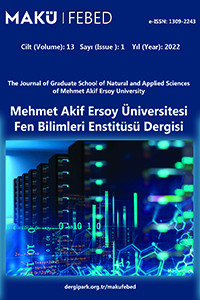Borik Asit Katkılı Sekonder Liflerden Yapılan Kompozit Malzemelerin Özellikleri
Geri dönüşümlü kağıt, kompozit, borik asit, mekanik özellikler, akustik özellikler
Properties of Composite Panels Made from Secondary Fibers with Boric Acid
Recycled paper, Composite, Boric acid, Mechanical properties, Acoustic properties,
___
- ASTM C1113/C1113M – 09 (2013). Standard Test Method for Thermal Conductivity of Refractories by Hot Wire (Platinum Resistance Thermometer Technique), ASTM International.
- Atchison, J.E. (1989). New developments in nonwood plant fiber pulping-a global perspective , Proce., Nonwood plant fibers, Progress report no. 19, Tappi press, Atlanta, GA, 253-274.
- Atchison, J.E. (1993). Data on non-wood plant fibers, In: Properties of fibrous raw materials and their preparation for pulping, M.J.Kocurek (Ed.), Joint textbook com. of the paper industry, Vol.3, Tappi Press, Atlanta,GA, 157-174.
- Dos Santos, R.C.; Mendes, L.M.; Morı, F.A.; Mendes, R.F. (2009). Particleboard produced from residues generated after the extraction of candeia wood oil (Eremanthus erythropappus). Scientia Forestalis 37 (84): 437-446.
- English, B., Chow, P., and Bajwa, D.S. (1997). Processing into Composites, In: Paper and Composites from Agro-based Resources, R.M. Rowell, R.A. Young, J.K. Rowell, (Eds), CRC Press Inc, Boca Raton, FL, pp.269-299.
- Eshraghi, A., Khademieslam, H. (2012). Waste paperboard in composition panels, Cellulose Chemistry and Technology, 46, 637-642.
- Grigoriou, A. (2003). Waste paper–wood composites bonded with isocyanate, Wood Science and Technology, 37(1): 79-90.
- Hänninen, T., and Hughes, M. (2010). Historical, contemporary and future applications. Industrial Applications of Natural Fibers, J. Müssig, Ed. Wiley, pp.385-395.
- Kaya, A.I and Sahin, H.T. (2016). The Effects of Boric Acid on Fiberboard Made from Wood/Secondary Fiber Mixtures: Part 3. Utilization of Recycled Waste Office Paper Fibers, American Chemical Science Journal, 16(3): 1-8.
- Kaya, A.I and Sahin, H.T. (2016).The Effects of Boric Acid on Fiberboard Made from Wood/Secondary Fiber Mixtures: Part 2. Utilization of Recycled Old Corrugated Container Fibers, American Chemical Science Journal, 16(2): 1-8.
- Kaya, A.I. (2015). A study of composite materials that produced from recovered fibers of recycled waste papers, Suleyman Demirel University, Graduate School of Applied and Natural Sciences, Ph.D thesis, (turkish, abstract in english) isparta, 239p.
- Kaya, A.I. and Sahin, H.T. (2016). The Effects of Boric Acid on Fiberboard Properties Made from Wood/Secondary Fiber Mixtures: Part 1. Utilization of Recycled Newsprint Paper Fibers, American Chemical Science Journal, 16 (1): 1-8.
- Nourbakhsh, A., Ashori, A., Jahan-Latibari, A. (2010). Evaluation of the physical and mechanical properties of medium density fiberboard made from old newsprint fibers. Journal of Reinforced Plastics and Composites, 29 (1): 5-11.
- Okino, E. Y. A., Santana, M. A. E., de Souza, M. R. (2000). Utilization of wastepaper to manufacture low density boards. Bioresource Technology, 73(1): 77-79.
- Rials, G. T and Wolcott, M.P. (1997). Physical and mechanical properties of agro-based fibers, In: Paper and composites from agro based resources, Rowell, R.M., Young, R.A., Rowell, J.K. (Eds), CRC Press, Inc, Boca Raton, Florida, p. 63-81.
- Rowell, R.M. (1997). Opportunities for composites from agro-based resources, In: Paper and composites from agro based resources, R.M. Rowell, R.A. Young, J.K. Rowell, (Eds), CRC Press Inc, Boca Raton, FL,7-19.
- Rowell, R.M. 1995. Composite materials from agricultural resources, In; Research industrial application of non-food crops, I. Plant fibres: proceeedings of a seminar, May 1995, O. Olesen, F. Rexen, J. Larsen, (Eds), Acad. of Tech. Sci., Denmark, 27-41.
- Springer, A., Rose, M., Ryu, R. (1996). Eco blocks: nontraditional use for mixed wastepaper. Journal of Environmental Engineering, 122 (5): 437-444.
- TS EN 622-5 (1999). Fibreboards - Specifications - Part 5: Requirements for dry process boards (MDF), Turkish Standards Institution, Ankara.
- TS EN ISO 10534-2. (2003). Acoustics Determination of Sound Absorption Coefficient and Impedance in Impedances Tubes-Part 2: Transfer-Function Method, Turkish Standards Institution, Ankara.
- Vasiliev, V.V., and Morozov, E. (2001). Mechanics and Analysis of Composite Materials, 1’st Edition, Elsevier Science, New York.
- White, G.A., and Cook, C. G. (1997). Inventory of agro-mass, In: Paper and composites from agro based resources, R.M. Rowell, R.A. Young, J.K. Rowell, (Eds), CRC Press Inc, Boca Raton, FL, 7-21.
- Yayın Aralığı: Yılda 2 Sayı
- Başlangıç: 2010
- Yayıncı: Burdur Mehmet Akif Ersoy Üniversitesi
Sürgü Çayı (Malatya, Türkiye)’nda Makrobentik Omurgasızların Tür Kompozisyonu ve Çeşitliliği
Serap KOŞAL ŞAHİN, Melek ZEYBEK
İki Ankrajlı Çelik Palplanş Sisteminin Optimum Tasarımı
Mehmet Fatih YAZICI, Sıddıka Nilay KESKİN
Merve Şehnaz İŞYARLAR, Ferhat GÜL
Okul Binalarında Bulunması Gereken Perde Duvar Oranı Üzerine Bir Çalışma
Hakan ULUTAŞ, Hakan DİLMAC, Hamide TEKELİ, Fuat DEMİR
Borik Asit Katkılı Sekonder Liflerden Yapılan Kompozit Malzemelerin Özellikleri
Ali İhsan KAYA, Halil Turgut ŞAHİN
Wilkinson Güç Birleştirici Kullanarak İki Girişli RF Enerji Hasatlama Devresi ve DC Yük Analizi
Ömer KASAR, Mesud KAHRİMAN, Mahmut Ahmet GÖZEL
Kızılçam’da (Pinus brutia Ten.) Fidan Kalitesi
Toros Sediri’nde (Cedrus libani A. Rich.) Fidan Tipi x Fidan Morfolojisi Etkileşimi
